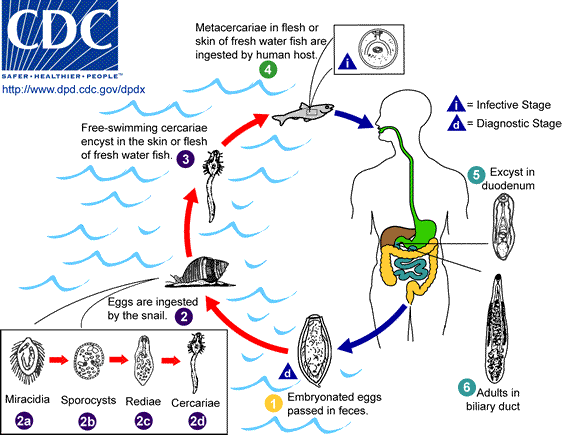Clonorchis
| style="background:#Template:Taxobox colour;"|Human liver fluke | ||||||||||||||
|---|---|---|---|---|---|---|---|---|---|---|---|---|---|---|
| style="background:#Template:Taxobox colour;" | Scientific classification | ||||||||||||||
| ||||||||||||||
| Binomial name | ||||||||||||||
| Clonorchis sinensis Looss, 1907 |
The Clonorchis sinensis is a human liver fluke in the class Trematoda, Phylum Platyhelminthes. This parasite lives in the liver of humans, and is found mainly in the common bile duct and gall bladder, feeding on bile. These animals, which are believed to be the third most prevalent worm parasite in the world, are endemic to Japan, China, Taiwan, and Southeast Asia, currently infecting an estimated 30,000,000 humans.
Life cycle

The egg of a Clonorchis sinensis (commonly: human liver fluke), which contains the miracidium that develops into the adult form, floats in freshwater until it is eaten by a snail.
Once inside of the snail body, the miracidium hatches from the egg, and parasitically grows inside of the snail. The miracidium develops into a sporocyst, which in turn house the asexual reproduction of redia, the next stage. The redia themselves house the asexual reproduction of free-swimming cercaria. This system of asexual reproduction allows for an exponential multiplication of cercaria individuals from one miracidium. This aids the Clonorchis in reproduction, because it enables the miracidium to captilatize on one chance occasion of passively being eaten by a snail before the egg dies.
Once the redia mature, having grown inside the snail body until this point, they actively bore out of the snail body into the freshwater environment. There, instead of waiting to be consumed by a host (as is the case in their egg stage), they seek out a fish. Boring their way into the fish's body, they again become parasites of their new hosts.
Once inside of the fish muscle, the cercaria create a protective metacercarial cyst with which to encapsulate their bodies. This protective cyst proves useful when the fish muscle is consumed by a human. The acid-resistant cyst enables the metacercaria to avoid being digested by the human gastric acids, and allows the metacercaria to reach the small intestine unharmed. Reaching the small intestines, the metacercaria navigate toward the human liver, which becomes its final habitat. Clonorchis feed on human bile created by the liver. In the human liver, the mature Clonorchis reaches its stage of sexual reproduction. The hermaphroditic adults produce eggs every 1–30 seconds, resulting in the rapid multiplication of inhabitants in the liver.
Effects on human health
Dwelling in the bile ducts, Clonorchis induces an inflammatory reaction, epithelial hyperplasia and sometimes even cholangiocarcinoma, the incidence of which is raised in fluke-infested areas.[1]
One adverse effect of Clonorchis is the possibility for the adult metacercaria to consume all bile created in the liver, which would inhibit the host human from digesting, especially fats. Another possibility is obstruction of the bile duct by the parasite or its eggs, leading to biliary obstruction and cholangitis (specifically oriental cholangitis).
Treatment
References
- ↑ Kumar et al: Robbins & Cotran Pathologic Basis of Disease 7E
- Freeman, Scott (2002). Biological Science. Upper Saddle River, Prentice Hall Inc.
- Gilbertson, Lance (1999). Zoology Laboratory Manual fourth edition. New York, The McGraw-Hill Companies, Inc.